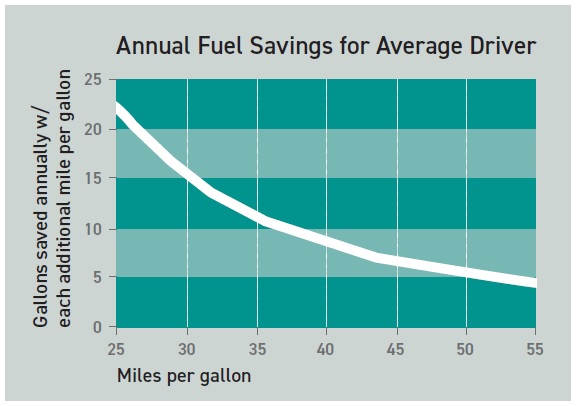At what cost fuel economy?
Don Smolenski | TLT Machinery February 2020
Increases in miles per gallon aren’t translating into driver savings.

This graph illustrates diminishing returns for drivers on savings with increasing mpg.
The U.S. Environmental Protection Agency fuel economy requirements mandated significant improvements in passenger car miles per gallon (54.5 mpg by 2025). Although these regulations may be relaxed, consumer demand will continue driving better fuel economy. The government has touted fuel economy benefits to drivers but has been mostly silent about how much the costs of such improvements will raise new vehicle prices (there is no such thing as a free lunch!).
First, let’s look at the benefit of fuel economy improvements to the average U.S. driver who logged 13,476 miles/year in 2018, according to the U.S. Environmental Information Administration (U.S. EIA). The graph shows the incremental number of gallons of gasoline saved annually for each mile-per-gallon improvement.
For instance, the improvement in fuel savings from 34 to 35 mpg is
13,476 miles/34 mpg – 13,476 miles/35 mpg = 396.4 - 385.0 = 11.4 gallons.
Obviously the cost of fuel is pretty unpredictable (I’d rather put my money on Old Glue Factory in the third race at Santa Anita than bet on future fuel prices), but according to the U.S. EIA, the average cost of regular fuel in 2018 was about $2.79/gallon, for an average driver savings of $31.80 annually. From 50 to 51 mpg, however, the savings is only 5.3 gallons, $14.80. This illustrates diminishing returns on savings with increasing mpg.
OK, so we understand the potential savings, but what about the cost? The U.S. Department of Transportation estimated the cost of an eight-mpg increase at $1,300 or $162.50/mpg in 2009. It’s important to consider that this was based on typical vehicle fuel economy at that time.
Now, 10 years later, the low-hanging fruit is gone, and improving fuel economy is continually costlier. There are several different ways to improve fuel economy, including reducing vehicle weight, reducing tire rolling resistance, improving aerodynamics and more efficient engines and transmissions. More efficient combustion, lower friction piston rings, direct injection, turbocharging, cylinder deactivation, stop-start, electrification and many more innovations are making engines continually more efficient.
Transmissions are changing as well. A few years ago, six-speed transmissions were pretty common. Now we see eight, nine and 10-speed, dual clutch, continuously variable and so on. Of course, better fuels and lubricants also are important—and one of the most cost-effective ways for OEMs to find improvements!
OEMs will use many or all of these and other innovations to improve efficiency. They are unlikely to publicly quote a hard cost/mpg improvement, as this might give competitors insight into their future fuel economy improvement plans. A cost of $200/mpg was kicked around as a ballpark figure a few years ago (and I believe that this is a very conservative number). So let’s use this just for illustrative purposes. The annual fuel savings from 34 to 35 mpg ($31.80/year), neglecting interest, shows that the payback period is $200 ÷ $31.80/year = 6.3 years. From 50 to 51 mpg ($14.80), there is a 13.5-year payback period. This is not a good deal for the consumer, and this even assumes no increases in cost from the $200/mpg estimate, which is extremely unlikely.
Can you take these estimates to the bank? Not really, and not the intent of this article, but it’s pretty clear that the average driver will not quickly, if ever, recover the increase in new vehicle cost at higher mpg. The point is that better fuel economy is a good thing, but it’s not free.
It would be useful if the cost increases were transparent so drivers can make their own educated decisions based on their perceptions of how long it will take to recover the increased vehicle cost.
Don Smolenski is president of his own consultancy, Strategic Management of Oil, LLC, in St. Clair Shores, Mich. You can reach him at donald.smolenski@gmail.com.